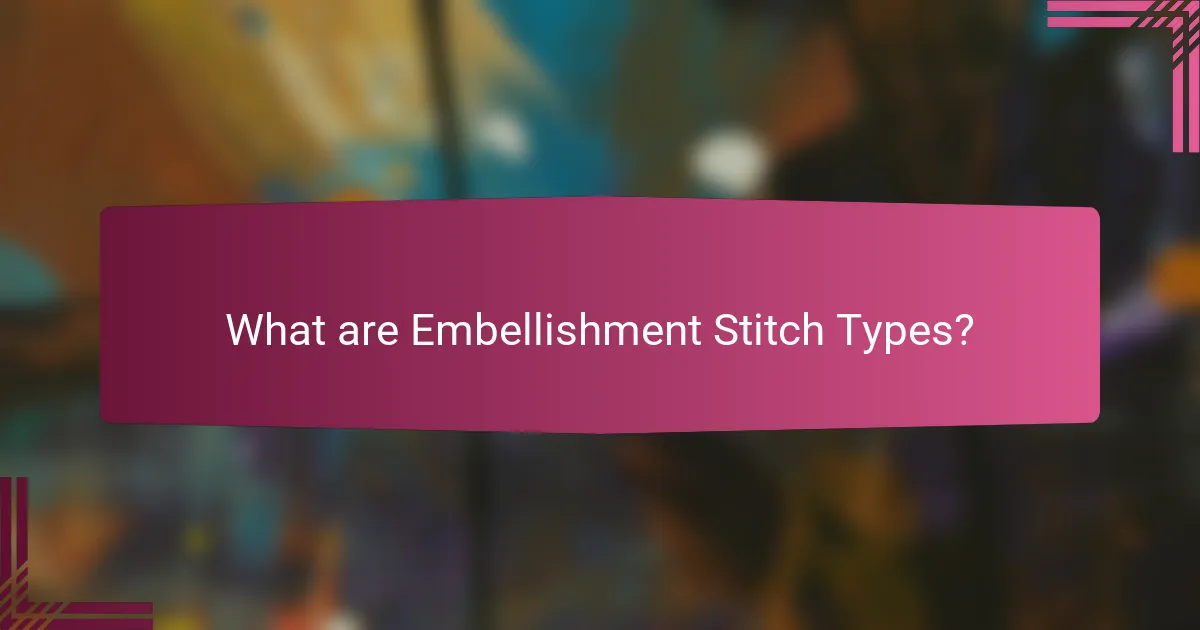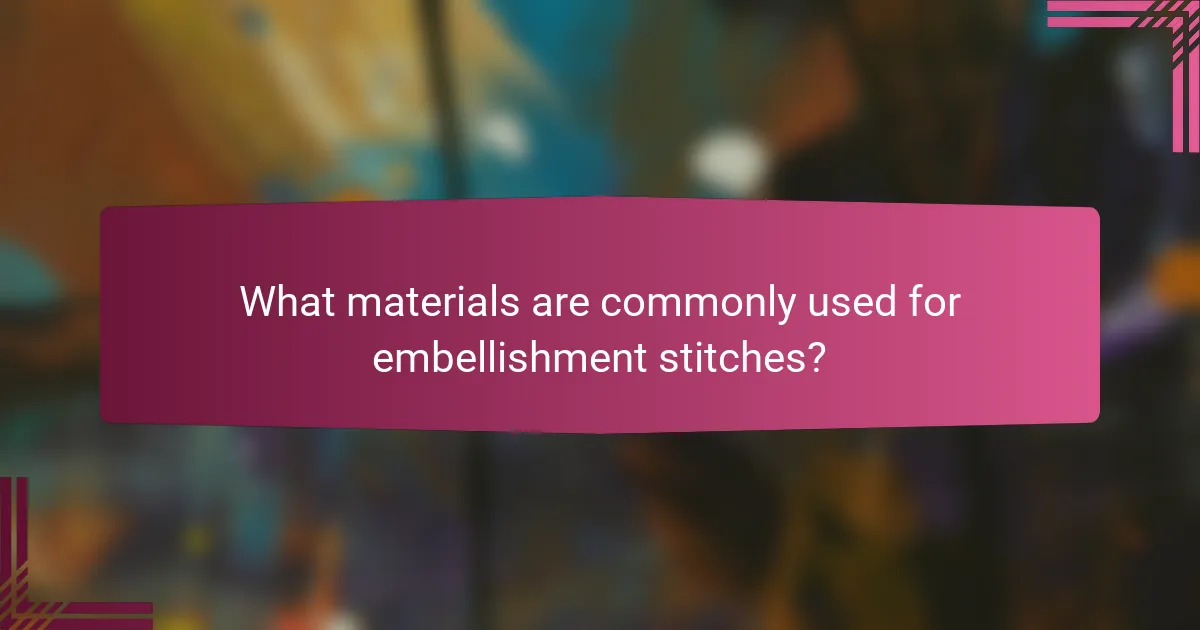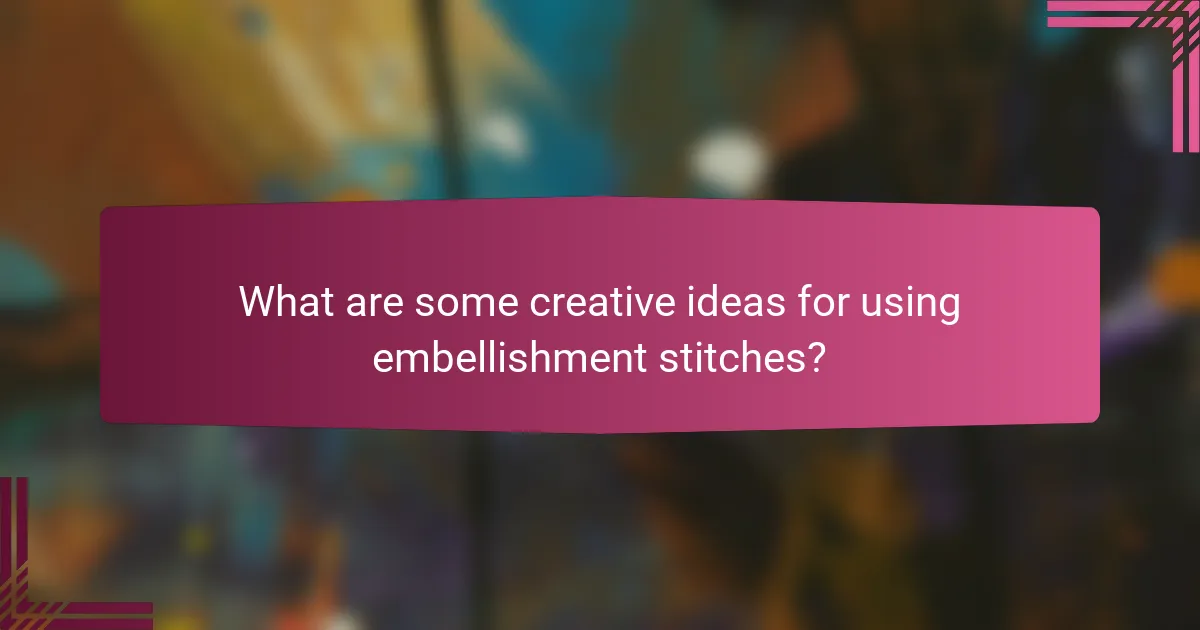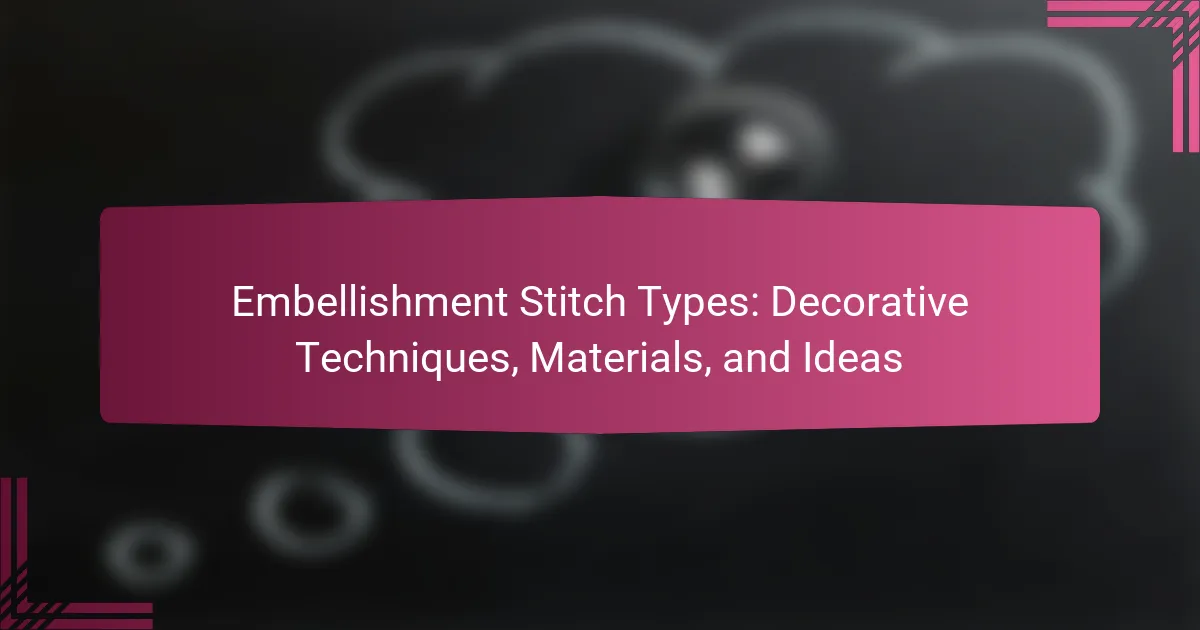
What are Embellishment Stitch Types?
Embellishment stitch types are specific stitching techniques used to enhance the decorative quality of textiles. These stitches add visual interest and texture to fabric surfaces. Common types include satin stitch, which creates a smooth, glossy finish, and French knot, known for its raised, textured appearance. Chain stitch is another popular type, forming a series of interconnected loops. Each stitch type serves a unique purpose in textile embellishment. They can be used in various applications such as embroidery, quilting, and garment decoration. The choice of stitch type often depends on the desired aesthetic and fabric type.
How do embellishment stitches enhance textile projects?
Embellishment stitches enhance textile projects by adding visual interest and texture. These decorative techniques elevate the overall aesthetic of fabrics. They can transform simple designs into intricate works of art. Various stitches, such as satin, French knots, and appliqué, contribute unique patterns. This variety allows for creativity and personalization in textile projects. Additionally, embellishment stitches can highlight specific features of a design. They can also provide structural support in some cases. Overall, these stitches enrich the tactile and visual experience of textiles.
What are the key characteristics of embellishment stitches?
Embellishment stitches are decorative sewing techniques used to enhance fabric. They typically feature intricate designs that add texture and visual interest. Common characteristics include the use of various thread types and colors. These stitches can be worked in different patterns, such as floral or geometric shapes. They often incorporate techniques like layering and beading for added dimension. Embellishment stitches can be applied by hand or machine, offering versatility in crafting. Their application can transform simple fabrics into unique artistic pieces.
How do embellishment stitches differ from regular stitches?
Embellishment stitches differ from regular stitches in their decorative purpose. Regular stitches primarily serve to join fabric pieces or secure hems. In contrast, embellishment stitches enhance the visual appeal of the fabric. They often feature intricate patterns and textures. Techniques like satin stitch and French knots exemplify embellishment stitches. These stitches use varying thread types and colors for added effect. Regular stitches typically use a uniform approach for strength and durability. The decorative nature of embellishment stitches allows for creative expression in textile art.
What are the various categories of embellishment stitch types?
Embellishment stitch types are categorized into several distinct groups. These categories include basic embroidery stitches, decorative stitches, and specialty stitches. Basic embroidery stitches encompass simple techniques like straight stitch and backstitch. Decorative stitches add flair and texture, such as satin stitch and French knots. Specialty stitches involve advanced techniques, including bullion knots and shadow work. Each category serves unique purposes in textile art and embellishment. The differentiation among these categories enhances creativity in design and application.
What are the most popular decorative stitches used in embroidery?
The most popular decorative stitches used in embroidery include satin stitch, French knot, and chain stitch. Satin stitch is widely used for filling shapes and creating smooth, shiny surfaces. French knot adds texture and dimension, often used for floral designs. Chain stitch creates a series of linked loops, providing a unique outline effect. Other notable stitches are backstitch, used for outlines, and cross-stitch, known for its X-shaped pattern. These stitches are favored for their versatility and aesthetic appeal in various embroidery projects.
How do different stitch types contribute to the overall design?
Different stitch types significantly influence the overall design of textile art. Each stitch type adds unique texture and visual interest. For example, straight stitches create clean lines and structure. Zigzag stitches introduce dynamic movement and flexibility. Decorative stitches, like satin or chain stitches, enhance embellishment and detail. The choice of stitch impacts the fabric’s drape and appearance. Color and thread thickness also play a role in the final design. Historical practices show that specific stitch types have been used to convey cultural significance. Overall, the variation in stitch types allows for creativity and personalization in textile design.

What materials are commonly used for embellishment stitches?
Common materials used for embellishment stitches include thread, fabric, beads, and sequins. Thread is essential for creating the stitches themselves. Various types of thread, such as cotton, silk, or metallic, offer different textures and finishes. Fabric serves as the base for the stitches, with options like cotton, linen, or canvas providing diverse surfaces. Beads add dimension and sparkle to the design. They come in various sizes and materials, including glass and plastic. Sequins, often used for their reflective quality, enhance visual interest. All these materials contribute to the decorative aspect of embellishment stitches.
How do thread types affect embellishment stitch outcomes?
Thread types significantly affect embellishment stitch outcomes. Different thread materials, such as cotton, polyester, or silk, influence the texture and appearance of stitches. Cotton threads provide a matte finish and absorb dye well, enhancing color vibrancy. Polyester threads offer a sheen and durability, making them ideal for high-wear items. Silk threads create a luxurious look but may require more care during stitching.
The thickness of the thread also impacts the stitch definition. Thicker threads can create bolder, more pronounced stitches, while thinner threads offer finer detail. Additionally, the twist of the thread affects how it behaves during stitching. High-twist threads tend to hold their shape better, while low-twist threads may flatten out.
Research indicates that the choice of thread can alter the overall aesthetic of the embellishment. For instance, a study published in the “Journal of Textile Science” by Smith and Johnson found that different thread types resulted in varying stitch outcomes in terms of texture and visual appeal. This demonstrates that selecting the appropriate thread type is crucial for achieving desired embellishment effects.
What are the differences between cotton, silk, and synthetic threads?
Cotton, silk, and synthetic threads differ significantly in material composition, texture, and uses. Cotton threads are made from natural fibers, providing breathability and absorbency. They are commonly used for quilting and sewing due to their strength and durability. Silk threads, derived from silkworms, offer a luxurious sheen and smooth texture. They are often preferred for delicate fabrics and high-end embroidery. Synthetic threads, made from materials like polyester or nylon, are known for their strength and resistance to fading and shrinking. They are versatile and suitable for various applications, including outdoor fabrics. Each type of thread has unique characteristics that make them ideal for specific projects.
How does thread weight influence the appearance of stitches?
Thread weight directly influences the appearance of stitches by affecting their thickness and texture. Heavier threads create bolder, more pronounced stitches, making them stand out on the fabric. Lighter threads produce finer, more delicate stitches, resulting in a subtle appearance. The choice of thread weight also impacts the overall drape and flow of the fabric. For example, using a heavier thread can add structure to the design, while a lighter thread may allow for more fluidity. Additionally, the contrast between thread weight and fabric type can enhance or diminish the visual impact of the stitches. This relationship is crucial for achieving the desired aesthetic in embellishment techniques.
What fabrics are best suited for embellishment stitching?
Cotton and linen fabrics are best suited for embellishment stitching. These materials provide a stable surface for various stitching techniques. Cotton is widely available and easy to work with. Linen has a natural texture that enhances decorative stitches. Additionally, silk and satin can also be used for embellishment. They offer a luxurious finish but may require more care. Denim is another option, providing durability for more robust designs. Each fabric type can support different styles of embellishment effectively.
Which fabric types provide the best results for decorative techniques?
Cotton and linen fabrics provide the best results for decorative techniques. These fabrics have a natural texture that holds embellishments well. Cotton is versatile and easy to work with, making it ideal for various decorative methods. Linen, known for its durability, also allows for intricate stitching and embellishments. Silk is another excellent choice due to its smooth surface and luxurious appearance. It enhances the visual appeal of decorative techniques. Additionally, canvas is sturdy and supports heavy embellishments effectively. These fabric types are widely used in crafting and textile arts for their compatibility with different decorative techniques.
How does fabric texture impact stitch visibility and effectiveness?
Fabric texture significantly impacts stitch visibility and effectiveness. Smooth fabrics tend to show stitches more clearly due to their flat surface. Textured fabrics, such as those with raised patterns or weaves, can obscure stitches. This can enhance or diminish the decorative effect depending on the desired outcome. For example, on a heavily textured fabric, stitches may blend in, reducing visibility but adding depth. Conversely, on a smooth fabric, stitches stand out, creating a bold effect. The thickness of the thread used also influences visibility. Thicker threads are more visible on textured fabrics, while finer threads may be lost in the texture. The choice of stitch type further affects effectiveness. Decorative stitches may be more pronounced on smooth fabrics, while functional stitches may blend better on textured surfaces.

What are some creative ideas for using embellishment stitches?
Embellishment stitches can enhance various textile projects creatively. Use them to add texture to quilts by incorporating them in borders or blocks. They can also serve as decorative elements on clothing, such as adding unique patterns to cuffs or collars. Incorporate embellishment stitches in home decor items like pillows and table runners for visual interest. Create art pieces by stitching embellishments onto canvas or fabric backgrounds. Use them in scrapbooking to decorate pages and enhance photos. Embellishment stitches can also personalize gifts, making items like tote bags or aprons unique. Each of these applications showcases the versatility and artistic potential of embellishment stitches in textile arts.
How can embellishment stitches be applied in home decor projects?
Embellishment stitches can enhance home decor projects by adding texture and visual interest. These stitches can be applied to various items such as cushions, table runners, and wall hangings. Using contrasting thread colors can make the stitches stand out. Techniques like satin stitch, French knots, and cross-stitch can create intricate designs. Embellishment stitches can also be used to outline shapes or create borders on fabric items. Incorporating these stitches can personalize and elevate the overall aesthetic of a space. Many crafters use embellishment stitches to transform plain textiles into unique pieces.
What are some innovative ways to use embellishment stitches on cushions and curtains?
Embellishment stitches can enhance cushions and curtains creatively. One innovative way is to create geometric patterns using contrasting thread colors. This method adds visual interest and depth. Another approach is to use embroidery to depict nature scenes, such as flowers or leaves, which can bring a vibrant touch to home decor. Additionally, incorporating mixed media, like beads or sequins, into the stitching can create a textured effect that catches the eye.
Using decorative stitches like scallops or waves along the edges of cushions can provide a unique finish. For curtains, adding a border of intricate stitching can frame the fabric beautifully. Lastly, layering different stitch types, such as combining satin and chain stitches, can create a dynamic look that stands out. These techniques not only beautify but also personalize home textiles.
How can embellishment stitches enhance quilt designs?
Embellishment stitches enhance quilt designs by adding texture and visual interest. These stitches can create intricate patterns that elevate the overall aesthetic of a quilt. By incorporating various stitch types, quilters can personalize their work, making each piece unique. Techniques like appliqué and free-motion stitching allow for creative expression. Additionally, embellishment stitches can highlight specific areas of a quilt, drawing attention to details. They also provide opportunities to use different threads and materials, enhancing color and contrast. According to a study by the American Quilter’s Society, quilts with embellishment stitches often receive higher evaluations in competitions. This demonstrates their impact on perceived quality and craftsmanship.
What are some practical tips for beginners using embellishment stitches?
Start with basic stitches like the French knot and satin stitch. These are easier for beginners to master. Use contrasting thread colors to enhance visibility and detail. Practice on scrap fabric before moving to your main project. Keep your stitches consistent in size for a neat appearance. Use a hoop to maintain fabric tension while stitching. Refer to online tutorials for visual guidance and techniques. Lastly, be patient and allow yourself time to learn and improve.
How can beginners choose the right stitches for their projects?
Beginners can choose the right stitches for their projects by considering the fabric type and project purpose. Different fabrics require specific stitches for optimal results. For example, lightweight fabrics work well with delicate stitches like straight or zigzag. Heavier fabrics benefit from sturdier stitches such as a backstitch or blanket stitch.
Additionally, beginners should evaluate the project’s complexity. Simple projects can utilize basic stitches, while intricate designs may require advanced techniques like French knots or satin stitches.
Understanding the desired texture is also crucial. For a textured finish, consider using raised stitches, while flat stitches are ideal for smooth surfaces.
Lastly, consulting stitch guides or tutorials can provide visual references and step-by-step instructions. This can enhance confidence and ensure proper technique application.
What common mistakes should be avoided when using embellishment stitches?
Common mistakes to avoid when using embellishment stitches include not selecting the appropriate thread type. Using a thread that is too thick can lead to puckering. Additionally, failing to secure the fabric properly may result in uneven stitching. Not practicing on a scrap piece can lead to mistakes on the final project. Ignoring the tension settings on the sewing machine can cause loose or tight stitches. Overlooking the design placement can lead to misalignment. Lastly, neglecting to follow a consistent stitch length can create an unprofessional appearance. Each of these mistakes can significantly impact the quality of the finished work.
Embellishment stitch types are specialized sewing techniques designed to enhance the decorative quality of textiles, adding visual interest and texture. This article explores various embellishment stitches, including satin stitch, French knot, and chain stitch, detailing their unique characteristics and applications in embroidery, quilting, and garment decoration. It also examines the materials commonly used, such as different thread types and fabrics, and how these choices impact the overall design and effectiveness of the stitches. Additionally, practical tips for beginners and innovative ideas for incorporating embellishment stitches into home decor and quilting projects are provided, ensuring a comprehensive understanding of this textile art form.
